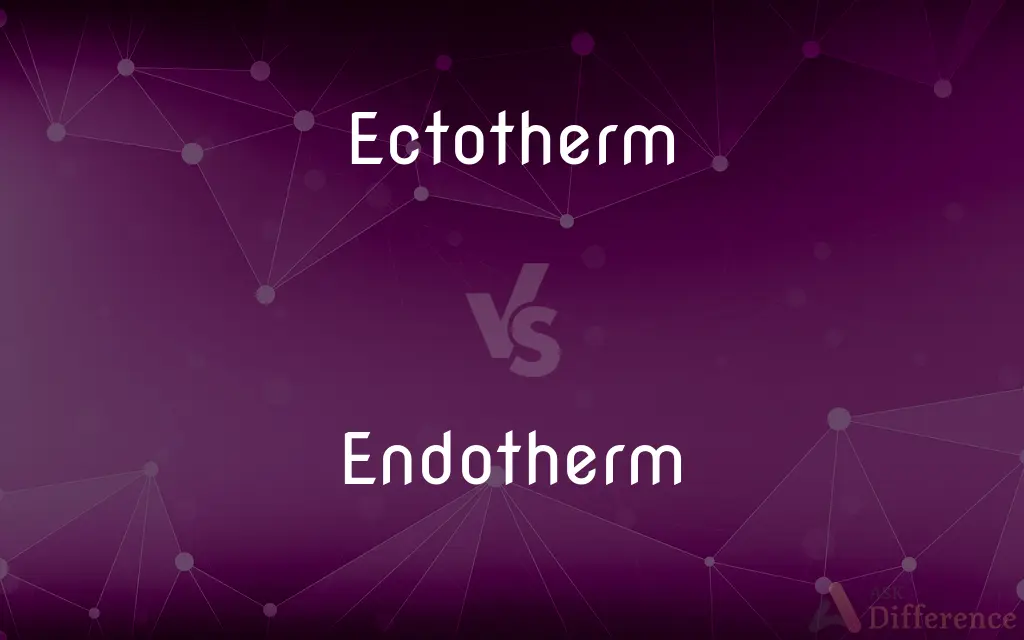Ectotherm vs. Endotherm — What's the Difference?
By Fiza Rafique & Maham Liaqat — Updated on March 13, 2024
Ectotherms rely on external heat sources to regulate their body temperature, while endotherms generate heat internally to maintain a stable body temperature.

Difference Between Ectotherm and Endotherm
Table of Contents
ADVERTISEMENT
Key Differences
Ectotherms, such as reptiles and amphibians, depend on environmental temperatures to regulate their body heat, often basking in the sun or seeking shade to adjust their temperature. On the other hand, endotherms, including mammals and birds, possess metabolic processes that generate internal heat, allowing them to maintain a consistent body temperature regardless of external conditions.
In terms of energy expenditure, ectotherms typically require less food and energy to sustain their body functions because they do not need to generate heat internally. Endotherms, however, must consume more food to fuel their higher metabolic rates, necessary for heat production and maintenance of body temperature.
Adaptation to environmental conditions is a distinguishing feature between ectotherms and endotherms. Ectotherms are often found in a wider range of environments because they can adapt their behavior to regulate temperature. Endotherms can inhabit more extreme environments, from hot deserts to cold tundras, due to their ability to internally regulate body temperature.
Activity levels in ectotherms and endotherms are influenced by their thermoregulatory methods. Ectotherms may be less active in cooler temperatures, as their body functions slow down. Endotherms, with their consistent body temperature, tend to have the capacity for sustained high levels of activity.
The evolutionary trade-offs between ectothermy and endothermy include energy efficiency versus environmental adaptability. Ectotherms are more energy-efficient but are limited by external temperatures, while endotherms can be active in a wider range of temperatures but at the cost of greater energy consumption.
ADVERTISEMENT
Comparison Chart
Heat Source
External environment
Internal metabolic processes
Energy Requirement
Lower, due to less need for internal heating
Higher, to support constant body temperature
Environmental Adaptation
Behaviorally adapt to temperature changes
Physiologically adapt to maintain temperature
Activity Level
Can vary with external temperature
Generally constant, not dependent on environment
Evolutionary Trade-off
Energy efficient but environmentally limited
High energy cost but adaptable to various environments
Compare with Definitions
Ectotherm
Dependent on external heat sources.
A lizard basks in the sun to raise its body temperature.
Endotherm
Generates internal heat.
Humans maintain a stable body temperature through metabolic activities.
Ectotherm
Low metabolic rate.
Ectotherms like snakes have slow metabolism, requiring less food.
Endotherm
High metabolic rate.
Birds require frequent feeding to sustain their high metabolism.
Ectotherm
Behavioral thermoregulation.
Frogs may seek shade or damp areas to cool down.
Endotherm
Adaptable to extreme environments.
Polar bears thrive in Arctic conditions due to their endothermic ability to regulate body heat.
Ectotherm
Energy efficiency.
Turtles can survive long periods without food thanks to their energy-efficient ectothermic nature.
Endotherm
Physiological thermoregulation.
Dogs pant to expel excess heat and maintain body temperature.
Ectotherm
Varied activity levels.
Fish in cold water might be less active due to reduced metabolic rates.
Endotherm
Constant activity level.
Mammals like deer remain active even in cold environments due to internal heat generation.
Ectotherm
An ectotherm (from the Greek ἐκτός (ektós) "outside" and θερμός (thermós) "heat") is an organism in which internal physiological sources of heat are of relatively small or of quite negligible importance in controlling body temperature. Such organisms (for example frogs) rely on environmental heat sources, which permit them to operate at very economical metabolic rates.Some of these animals live in environments where temperatures are practically constant, as is typical of regions of the abyssal ocean and hence can be regarded as homeothermic ectotherms.
Endotherm
An endotherm (from Greek ἔνδον endon "within" and θέρμη thermē "heat") is an organism that maintains its body at a metabolically favorable temperature, largely by the use of heat released by its internal bodily functions instead of relying almost purely on ambient heat. Such internally generated heat is mainly an incidental product of the animal's routine metabolism, but under conditions of excessive cold or low activity an endotherm might apply special mechanisms adapted specifically to heat production.
Ectotherm
An organism that depends on external sources for its body heat.
Endotherm
An organism that generates heat to maintain its body temperature, typically above the temperature of its surroundings.
Ectotherm
(biology) An animal, such as an amphibian, fish, reptile, or arthropod, which has a limited ability to regulate its body temperature and whose body temperature thus depends on the ambient temperature.
Endotherm
(biology) an animal that maintains a constant body temperature
Ectotherm
An animal whose body temperature varies with the temperature of its surroundings; any animal except birds and mammals
Common Curiosities
Why do endotherms need more food than ectotherms?
Endotherms require more food to fuel the metabolic processes necessary for internal heat production and maintaining body temperature.
What defines an ectotherm?
Ectotherms are organisms that regulate their body temperature through external means, relying on environmental heat sources.
Are all reptiles ectotherms?
Yes, all reptiles are classified as ectotherms, as they depend on external heat sources for thermoregulation.
What role does behavior play in the thermoregulation of ectotherms?
Behavior is crucial for ectotherms, as they must seek out environmental conditions that allow them to regulate their body temperature.
How do endotherms maintain their body temperature?
Endotherms maintain their body temperature through internal metabolic processes that generate heat.
What advantages do endotherms have over ectotherms?
Endotherms can maintain high levels of activity across a wide range of temperatures and inhabit more extreme environments.
How do endotherms adapt to extremely hot environments?
Endotherms adapt to hot environments through physiological mechanisms like sweating or panting to dissipate excess body heat.
Do endotherms ever use behavioral strategies to regulate their temperature?
While less reliant on behavior compared to ectotherms, endotherms can still use strategies like seeking shade or burrowing to aid in temperature regulation.
Can ectotherms survive in cold environments?
Ectotherms can survive in cold environments by using behavioral strategies to regulate their body temperature, but their activity levels may be reduced.
How does the thermoregulation method of ectotherms affect their energy consumption?
Ectotherms have lower energy consumption due to their reliance on external heat sources and lower metabolic rates.
Can an ectotherm's environment affect its growth and development?
Yes, the temperature of an ectotherm's environment can significantly affect its growth, development, and reproductive rates.
What are some physiological adaptations of endotherms for thermoregulation?
Physiological adaptations in endotherms include insulation (like fur or feathers), sweating, panting, and shivering.
How do aquatic ectotherms manage their body temperature?
Aquatic ectotherms, like fish, may move to different water depths or areas with varying temperatures to regulate their body heat.
What is torpor, and how does it relate to thermoregulation in endotherms?
Torpor is a state of reduced metabolic rate and body temperature in endotherms, used as an energy-saving strategy during unfavorable conditions.
Are there any exceptions to the typical ectotherm and endotherm classifications?
While most organisms clearly fall into one category or the other, some species exhibit mixed traits or can switch between ectothermy and endothermy under certain conditions.
Share Your Discovery

Previous Comparison
Joy vs. Unjoy
Next Comparison
Muscovite vs. BiotiteAuthor Spotlight
Written by
Fiza RafiqueFiza Rafique is a skilled content writer at AskDifference.com, where she meticulously refines and enhances written pieces. Drawing from her vast editorial expertise, Fiza ensures clarity, accuracy, and precision in every article. Passionate about language, she continually seeks to elevate the quality of content for readers worldwide.
Co-written by
Maham Liaqat













































